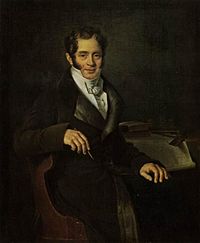

December 18, 1775 was born one of the great architects of St. Petersburg, an outstanding Russian architect of Italian origin, Carl Rossi. He was born in Naples, but at the age of 12 he came to Russia with his mother, the famous Italian ballerina Gertrud Rossi, and stepfather. Architect Vincenzo Brenna, who often visited Italian artists, became interested in a talented boy, becoming his first teacher. When in 1795 Brenna broke his arm, he took the draftsman of a young Charles Rossi.
After Paul I ascended to the throne, the construction of the Mikhailovsky Castle begins, the project of which was initially entrusted to the architect Vasily Ivanovich Bazhenov, and later transferred to Brenna. Work as a draftsman during the construction of the Mikhailovsky Castle was the first serious architectural practice for Charles Rossi.
Carl Rossi in 1811 becomes a member of the council for the improvement of Tver, where he designs the theater, the provincial chancery, the seminary, the hospital, the shopping arcade, the Church of the Three Hierarchs, the Cathedral of the Cross Exaltation Monastery. In addition, he designed the cathedral in Torzhok, the buildings of the places of interest in Staritsa, the drawing-room yards in Bezhetsk and Rybinsk. The early works of Rossi in St. Petersburg and its environs include the reconstruction of the Anichkov Palace in 1816, a number of pavilions and a library in the Pavlovsky Palace, the Elagin Palace with greenhouses and pavilions.
Nevertheless, Rossi became famous for creating urban architectural ensembles – the ensemble of the Mikhailovsky Palace with a garden and square, the ensemble of the Palace Square with the headquarters building and the triumphal arch, the Senate Square with the buildings of the Senate and the Synod, Alexandrinsky Square with the buildings of the Alexandrinsky Theater and the new building of the Imperial Public Library.
A harmonious combination of architectural forms and volumes, a unique vision and the ability to organize space, innovative constructive techniques – all this allowed Carlo Rossi to create a new face of Petersburg, grandiose and monumental.
Entering into a conflict with the environment of Nicholas I, Rossi retired in 1832, resigning “from all classes on buildings.” One of the last buildings of Rossi was the bell tower of the St. George’s Monastery near Veliky Novgorod.